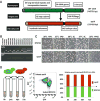Bug mapping and fitness testing of chemically synthesized chromosome X
- PMID: 28280152
- PMCID: PMC5679077
- DOI: 10.1126/science.aaf4706
Bug mapping and fitness testing of chemically synthesized chromosome X
Abstract
Debugging a genome sequence is imperative for successfully building a synthetic genome. As part of the effort to build a designer eukaryotic genome, yeast synthetic chromosome X (synX), designed as 707,459 base pairs, was synthesized chemically. SynX exhibited good fitness under a wide variety of conditions. A highly efficient mapping strategy called pooled PCRTag mapping (PoPM), which can be generalized to any watermarked synthetic chromosome, was developed to identify genetic alterations that affect cell fitness ("bugs"). A series of bugs were corrected that included a large region bearing complex amplifications, a growth defect mapping to a recoded sequence in FIP1, and a loxPsym site affecting promoter function of ATP2 PoPM is a powerful tool for synthetic yeast genome debugging and an efficient strategy for phenotype-genotype mapping.
Copyright © 2017, American Association for the Advancement of Science.
Figures




Comment in
-
Synthetic yeast chromosomes help probe mysteries of evolution.Nature. 2017 Mar 9;543(7645):298-299. doi: 10.1038/nature.2017.21615. Nature. 2017. PMID: 28300123 No abstract available.
-
Synthetic Biology: Building a custom eukaryotic genome de novo.Nat Rev Genet. 2017 Apr 12;18(5):274. doi: 10.1038/nrg.2017.30. Nat Rev Genet. 2017. PMID: 28400600 No abstract available.
References
Publication types
MeSH terms
Grants and funding
- BB/M00029X/1/BB_/Biotechnology and Biological Sciences Research Council/United Kingdom
- BB/M005690/1/BB_/Biotechnology and Biological Sciences Research Council/United Kingdom
- BB/M025640/1/BB_/Biotechnology and Biological Sciences Research Council/United Kingdom
- T32 GM007308/GM/NIGMS NIH HHS/United States
LinkOut - more resources
Full Text Sources
Other Literature Sources
Molecular Biology Databases
Research Materials

